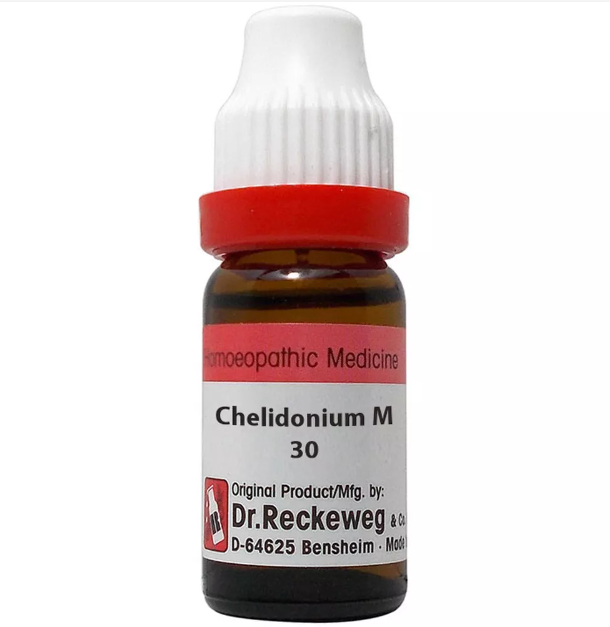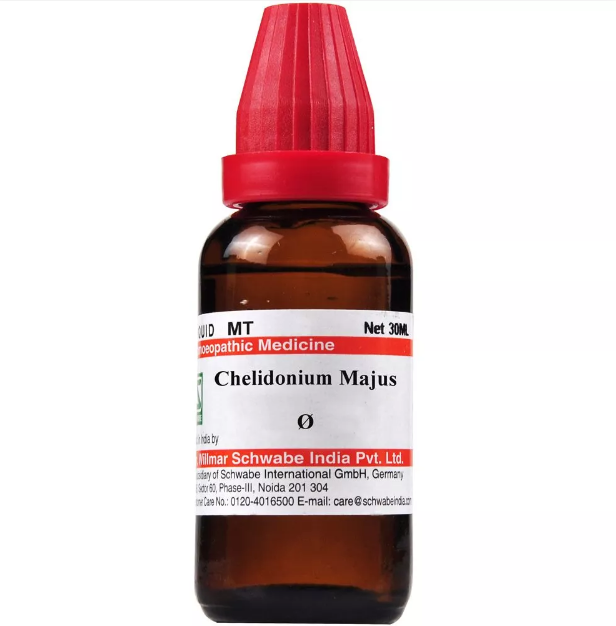CHELIDONIUM MAJUS Q, 6C, 12C, 30C, 200C, 1M, 10M USES AND SYMPTOMS
 CHELIDONIUM MAJUS
CHELIDONIUM MAJUS
Chel.
A notable liver remedy addressing numerous direct reflex symptoms associated with liver disease. Key indications include jaundiced skin and persistent pain under the right scapula’s inferior angle. Symptoms include paralytic drawing and lameness in specific parts, general lethargy, and reluctance to exert effort. Conditions worsen or recur with weather changes. Also treats serous effusions, hydrocele, and biliary issues during pregnancy.
Head: Icy cold occiput from nape to neck; feels leaden. Marked lethargy, drowsiness, general numbness; vertigo linked to liver issues. Tendency to fall forward. Right-sided headache extending down behind ears to the shoulder blade (migraine). Right eye, cheekbone, and ear neuralgia with excessive tearing, preceded by liver pain.
Eyes: Dirty yellow sclera. Sore feeling when looking up. Profuse tearing. Right eye orbital neuralgia with heavy tearing; contracted pupils, relieved by pressure.
Nose: Flapping of alae nasi (Lyc.).
Face: Yellow, worse on nose and cheeks. Wilted skin.
Stomach: Yellow tongue with teeth imprints; large, flabby. Bitter, pasty taste. Bad breath. Prefers hot food and drinks. Nausea and vomiting improved by hot water. Pain through the stomach to back and right shoulder blade. Gastralgia. Temporary relief from eating, especially with liver symptoms.
Abdomen: Jaundice due to liver and gall bladder blockage. Gall colic (cholecystitis). Distention, fermentation, sluggish bowels. Constriction feeling across the abdomen. Enlarged liver. Gallstones (Berb.).
Stool: Constipation with hard, round, bright yellow, pasty stools like sheep’s dung; clay-colored stools float in water; alternation of diarrhea and constipation. Burning and itching in the anus (Rat., Sulph.).
Urinary: Profuse, foamy, yellow urine like beer (Chen-a.), dark and turbid.
Female: Menses delayed and profuse.
Respiratory: Rapid, shallow breaths; pain with deep inspiration. Dyspnea. Short, exhausting cough; sensation of dust not relieved by coughing. Whooping cough; spasmodic, loose, rattling cough; difficult expectoration (pneumonia). Right chest and shoulder pain with troubled breathing. Small mucus lumps expelled when coughing. Hoarse in the afternoon. Chest constriction.
Back: Pain in nape. Stiff neck, head pulled left. Fixed pain under right scapula’s inner and lower angle. Pain at left scapula’s lower angle.
Extremities: Pain in arms, shoulders, hands, and fingertips. Icy cold fingertips; sore wrists, tearing in metacarpal bones (rheumatism). Flesh sore to touch. Rheumatic pain in hips and thighs; severe heel pain as if pinched by a narrow shoe; worse on the right. Feels paralyzed. Paresis of lower limbs with muscle rigidity.
Skin: Dry, itchy, yellow skin. Painful red pimples and pustules. Old, spreading, offensive ulcers. Wilted, sallow, cold, clammy skin.
Modalities: Worse on the right side, with motion, touch, weather changes, very early morning. Better after dinner, from pressure.
Relationship: Chelidoninum (spasm of smooth muscles, intestinal and uterine colic, bronchial spasm, tachycardia, etc.). Boldo (Boldo fragrans) for bladder atony, cholecystitis, biliary calculus, bitter taste, no appetite, constipation, hypochondriasis, liver congestion, burning weight in liver and stomach, painful liver diseases, liver issues post-malaria. Elemuy (Gauteria) for kidney and bladder stones; grain doses of powdered bark in water or 5 drops of tincture. Pellagra. Sulphur often complements its action.
Complementary: Lyc., Bry.
Antidote: Cham.
Compare: Nux-v., Sulph., Bry., Lyc., Op., Podo., Sang., Ars.
Dose: Tincture and lower attenuations.
SYMPTOMS OF CHELIDONIUM MAJUS
Head:
Icy cold occiput from nape to neck, feeling heavy as lead
Marked lethargy, drowsiness, and general numbness
Vertigo linked to liver issues
Tendency to fall forward
Right-sided headache extending down behind ears to the shoulder blade (migraine)
Neuralgia over the right eye, cheekbone, and ear with excessive tearing, preceded by liver pain
Eyes:
Dirty yellow sclera
Sore feeling when looking up
Profuse tearing
Right eye orbital neuralgia with heavy tearing
Contracted pupils, relieved by pressure
Nose:
Flapping of alae nasi
Face:
Yellow complexion, worse on nose and cheeks
Wilted skin
Stomach:
Yellow tongue with teeth imprints; large, flabby
Bitter, pasty taste
Bad breath
Preference for hot food and drinks
Nausea and vomiting improved by hot water
Pain through the stomach to back and right shoulder blade
Gastralgia
Temporary relief from eating, especially with liver symptoms
Abdomen:
Jaundice due to liver and gall bladder blockage
Gall colic (cholecystitis)
Distention, fermentation, and sluggish bowels
Constriction feeling across the abdomen
Enlarged liver
Gallstones
Stool:
Constipation with hard, round, bright yellow, pasty stools like sheep’s dung
Clay-colored stools float in water
Alternation of diarrhea and constipation
Burning and itching in the anus
Urinary:
Profuse, foamy, yellow urine like beer
Dark and turbid urine
Female:
Menses delayed and profuse
Respiratory:
Rapid, shallow breaths
Pain with deep inspiration
Dyspnea
Short, exhausting cough
Sensation of dust not relieved by coughing
Whooping cough; spasmodic, loose, rattling cough; difficult expectoration (pneumonia)
Right chest and shoulder pain with troubled breathing
Small mucus lumps expelled when coughing
Hoarse in the afternoon
Chest constriction
Back:
Pain in nape
Stiff neck, head pulled left
Fixed pain under right scapula’s inner and lower angle
Pain at left scapula’s lower angle
Extremities:
Pain in arms, shoulders, hands, and fingertips
Icy cold fingertips
Sore wrists, tearing in metacarpal bones (rheumatism)
Flesh sore to touch
Rheumatic pain in hips and thighs
Severe heel pain as if pinched by a narrow shoe, worse on the right
Feels paralyzed
Paresis of lower limbs with muscle rigidity
Skin:
Dry, itchy, yellow skin
Painful red pimples and pustules
Old, spreading, offensive ulcers
Wilted, sallow, cold, clammy skin
Modalities:
Worse on the right side, with motion, touch, weather changes, very early morning
Better after dinner, from pressure
selection of the potency
Individualization:
- Homeopathy is based on the principle of treating the individual, not just the disease. The unique symptoms and characteristics of the person are crucial in determining the most suitable potency.
Intensity of Symptoms:
- The intensity of the symptoms guides the choice of potency. If the symptoms are intense and acute, a lower potency (e.g., 6C, 30C) might be considered. For chronic conditions with less intensity, higher potencies (e.g., 200C, 1M) may be appropriate.
Sensitivity of the Patient:
- Some individuals are more sensitive to homeopathic remedies, while others may require higher potencies. The practitioner considers the patient’s sensitivity when selecting the potency.
Acute vs. Chronic Conditions:
- Lower potencies are often used for acute conditions, while higher potencies may be considered for chronic or long-standing issues.
Previous Response to Potencies:
- The patient’s response to previous homeopathic treatments helps guide the choice of potency. If a particular potency has been effective in the past, it may be repeated or adjusted as needed.
Vital Force and Susceptibility:
- Homeopathy views illness as a disturbance in the vital force. The practitioner assesses the patient’s overall vitality and susceptibility to determine the appropriate potency.
Aggravation or Amelioration:
- The direction of the symptom response (aggravation or amelioration) after taking a remedy can influence the choice of potency.
Miasmatic Considerations:
- In classical homeopathy, the concept of miasms (inherited disease tendencies) is considered. The practitioner take this into account when selecting the potency.
Practitioner Experience:
- The experience and preference of the homeopathic practitioner play a role. Some practitioners may have success with certain potencies based on their clinical experience.
SAFETY INFORMATION
- Do not exceed the recommended dose by physician
- Keep out of the reach of children
- Store in a cool dry place away from direct sunlight
- Maintain half an hour gap between food/drink/any other medicines and homoeopathic medicine
- Avoid any strong smell in the mouth while taking medicine e.g. camphor, garlic, onion, coffee, hing
Medicine images use for reference only selection of homeopathic medicine depends on the individual’s specific symptoms and overall constitution. Moreover, homeopathy is a holistic system of medicine that treats the individual as a whole. In addition to addressing the physical symptoms, it takes into account the emotional and mental state of the person. Consequently, it’s crucial to consult with a qualified homeopathic practitioner for personalized treatment.
The information provided on this website is intended solely for educational purposes. Always seek the advice of your physician or other qualified health provider.
